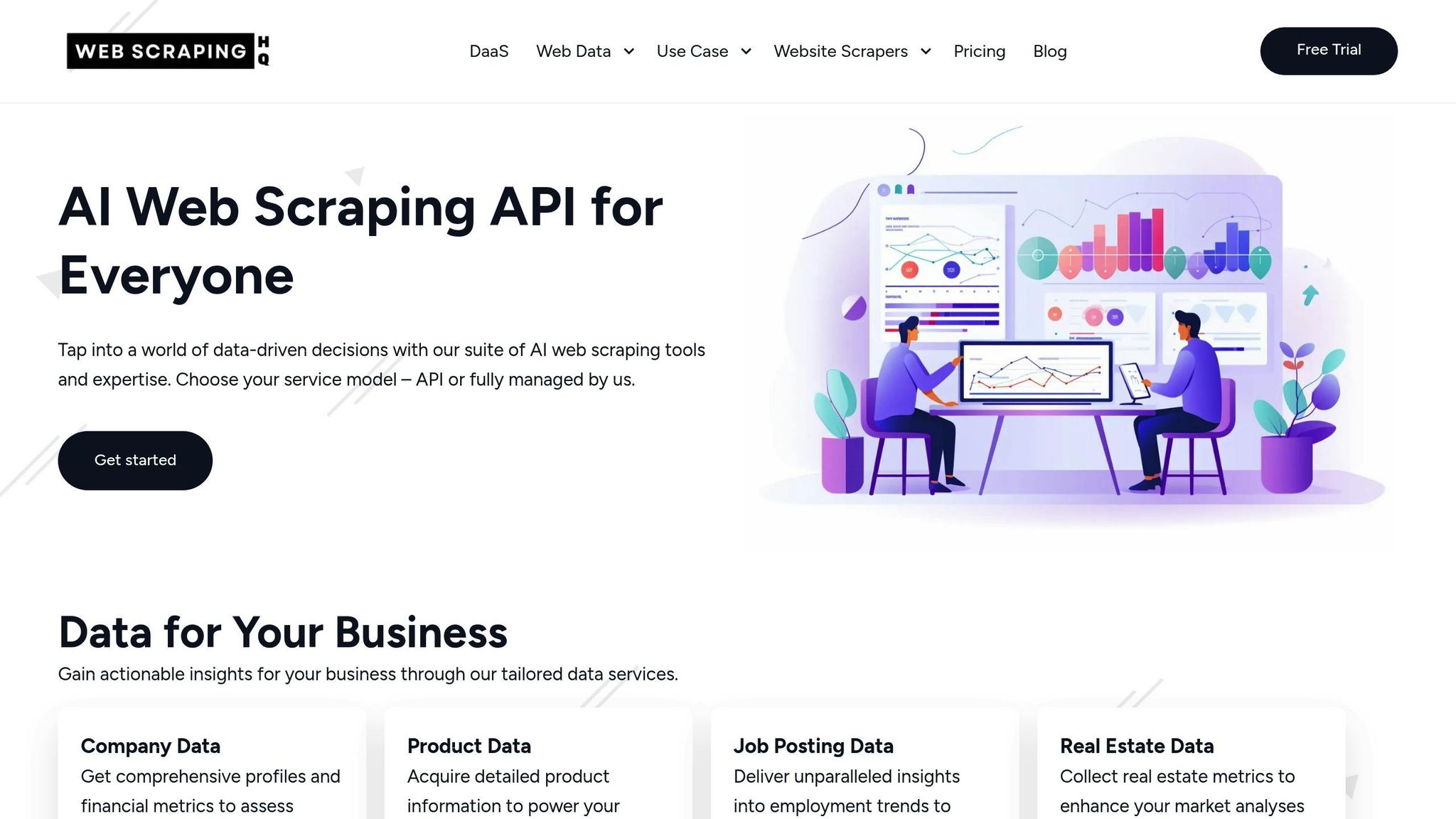
- Harsh Maur
- March 30, 2025
- 8 Mins read
- WebScraping
Why do You Need a YouTube comments scraper?
A YouTube comments scraper automates collecting and analyzing comments from videos, saving time and offering valuable insights for businesses and creators. Here’s why it matters:
- Understand Audience Sentiment: Analyze thousands of comments to gauge public opinion, track trends, and improve content or products.
- Save Time: Manually reviewing comments is slow and inefficient. Scrapers handle large volumes of data quickly.
- Real-Time Feedback: Monitor new comments as they appear to stay updated on audience reactions.
- Content and Product Improvement: Use feedback to refine content strategies or develop better products.
By automating data collection, a scraper helps businesses make informed decisions based on accurate, large-scale data.
| Feature | Why It Matters |
|---|---|
| Fast Data Collection | Handle millions of comments efficiently |
| Sentiment Analysis | Understand audience emotions and trends |
| Market Research | Spot trends and track engagement |
| Content Planning | Create targeted, audience-driven content |
A YouTube comments scraper is a powerful tool for businesses aiming to leverage audience insights for growth.
Main Advantages of YouTube Comments Scrapers
A YouTube comments scraper automates the process of gathering and analyzing comments, making it easier to gain useful insights quickly. This tool streamlines data collection and provides a scalable way to handle massive amounts of information.
Fast Data Collection at Scale
With over 700 hours of video uploaded every minute and 2.49 billion monthly active users, YouTube generates an overwhelming amount of comments. Manually collecting this data is nearly impossible. Automated scrapers handle this challenge by continuously capturing millions of comments, offering a broad dataset that highlights trends as they emerge, without the need for manual effort.
Improved Sentiment Analysis
Sentiment analysis becomes much more effective when large datasets are involved. A YouTube comments scraper can process thousands of comments, uncovering audience sentiment patterns that manual reviews often overlook. To boost sentiment analysis, you can:
- Use NLP tools to dive deeper into audience emotions.
- Apply keyword filters to focus on specific feedback.
- Monitor sentiment trends over time to understand shifts in opinions.
These tools not only make sentiment analysis more accurate but also speed up the entire market research process.
Accelerated Market Research
By combining rapid data collection with detailed sentiment analysis, these scrapers help deliver faster market research results. They enable you to:
- Monitor audience reactions in real-time.
- Spot new trends as they develop.
- Gather instant feedback on products or services.
- Track engagement across various videos.
This automation saves time and ensures you stay ahead in understanding your audience.
Common Applications of Comment Scraping
A YouTube comments scraper can be a powerful tool for businesses looking to gain deeper insights into their audience. By analyzing comments, companies can uncover valuable data to inform decisions across various areas.
Measuring Brand Perception
Brands often use this scraper to monitor how the public feels about them in real-time. With YouTube generating over 2.5 billion views in 2024, comments serve as a direct source of customer feedback. By analyzing this feedback, businesses can track sentiment trends, identify potential PR issues, evaluate campaign performance, and measure customer satisfaction.
For example, during the December 2024 #adventcalendar campaign, 9,246 mentions were analyzed, reaching 114 million people. Of these, over 35% were positive, while only 1.5% were negative. This level of detail helps brands fine-tune their strategies based on audience reactions.
Enhancing Content Planning
A comments scraper can transform audience feedback into actionable insights for content strategy. By analyzing patterns in timing, language, and themes, businesses can eliminate guesswork and create more targeted content.
| Aspect | Key Metrics | Why It Matters |
|---|---|---|
| Engagement Patterns | Time stamps of high activity | Identify the best posting times |
| Topic Preferences | Frequently discussed themes | Guide content direction |
| Audience Questions | Common queries | Inspire future content ideas |
| Language Used | Vocabulary and tone | Align communication style |
This data-driven approach ensures content resonates with the audience and can even inform product development, as discussed next.
Generating Product Development Ideas
YouTube comments are a goldmine for identifying ways to improve products or develop new ones. By analyzing these comments, companies can uncover feature requests, pain points, and competitive advantages. A scraper helps businesses:
- Detect emerging trends quickly
- Categorize feedback by sentiment
- Recognize patterns for improvement
- Turn insights into actionable development plans
The process involves several steps:
1. Daily Monitoring
Regularly track new comments and trends to stay updated.
2. Sentiment Classification
Organize feedback into categories, such as positive, negative, or neutral.
3. Pattern Recognition
Identify recurring themes or areas needing attention.
4. Action Planning
Use these insights to prioritize and implement changes.
sbb-itb-65bdb53
Technical Basics of Comment Scrapers
Grasping the core principles behind a YouTube comments scraper is key to collecting data effectively while staying within the platform's rules. Below, we'll break down the main components and practices for scraping comments.
Steps in Comment Scraping
Scraping YouTube comments involves several stages, each serving a specific purpose. Here's an overview of how a typical scraper works:
| Stage | Action | Purpose |
|---|---|---|
| Setup | Configure scraping parameters | Define the scope and limits |
| Authentication | Establish connection | Ensure authorized access |
| Data Collection | Extract specified comments | Gather raw data |
| Processing | Clean and structure the data | Prepare for analysis |
| Storage | Save formatted results | Ensure data integrity |
The cost of scraping depends on the number of comments you need. For example, scraping 100 comments without replies costs $0.35, while including replies raises the cost to $0.65. For larger datasets, like 10,000 comments, prices range from $1.00 to $1.30 when replies are included.
Key Features of a Good Scraper
A reliable scraper should include the following features to ensure effective data collection:
- Comment Volume Control: Specify exactly how many comments to extract.
- Reply Management: Choose whether to include or exclude replies.
- Author Information: Collect usernames and profile URLs.
- Scheduling: Automate scraping with options like "Deliver new items only."
- Data Organization: Sort data by date, username, or engagement metrics.
Staying Within YouTube's Rules
Adhering to YouTube's terms of service is essential for responsible scraping. The platform uses several methods to monitor scraping activity, so it's important to follow best practices:
1. Access Management
YouTube monitors user behavior through IP addresses and user-agent strings. To avoid triggering rate limits, introduce delays between requests.
2. Data Privacy
Respect user privacy by:
- Collecting only publicly available information.
- Avoiding any personally identifiable information (PII).
- Storing data securely and in line with privacy regulations.
3. Resource Usage
Optimize your scraping activities by:
- Checking total comment counts before setting limits.
- Scheduling smaller, regular scrapes instead of large, bulk operations.
- Using the "new items only" option for ongoing monitoring.
While scraping public comments is legal, it's important to do so responsibly, without affecting YouTube's performance or violating user privacy. Stay updated on YouTube's terms of service to ensure compliance.
Solving Common Scraping Problems
This section dives into practical challenges and solutions you might face when scraping YouTube comments, building on the earlier technical foundations.
Handling Access Limits
YouTube has strict measures to prevent excessive automated activity. For example, the YouTube Data API enforces a daily limit of 10,000 units. Different operations use these units at varying rates - 100 units for a video search versus just 1 for a comment.
Here’s how you can work around these limits:
- Use rotating residential proxies to spread out requests and avoid IP bans.
- Distribute requests across multiple sessions to avoid predictable patterns.
If you're scraping 10 million comments, with each averaging 400 KB, and residential proxies cost $3 per GB, expect to spend about $9,000 per month on proxy services.
Beyond managing access, keeping your data clean and relevant is just as important.
Maintaining Data Quality
Scraped data often includes irrelevant content, spam, or incomplete information. To make the data useful, you’ll need to filter and clean it. Here are some strategies:
| Data Quality Factor | Solution Approach | Impact |
|---|---|---|
| Comment Relevance | Keyword filtering | Removes irrelevant content for better focus |
| Language Accuracy | Language detection | Aligns comments with your audience's language |
| Data Completeness | Structured extraction | Maintains context and usability of the data |
Meeting Legal Requirements
When scraping YouTube comments, it’s crucial to follow legal and privacy guidelines.
Privacy Protection:
- Avoid collecting personally identifiable information (PII).
- Store data securely and in line with privacy regulations.
- Respect user privacy settings.
Platform Compliance:
- Regularly check YouTube's robots.txt file to understand restricted areas.
- Follow YouTube's rate-limiting rules.
- Avoid actions that could overwhelm or disrupt YouTube's servers.
Using web scraping APIs for compliant data collection typically costs between $0.0010 and $0.0050 per request. For large-scale operations handling about 10 million pages per month, this translates to costs ranging from $10,000 to $50,000.
Getting Started with Comment Scraping
Why Use a YouTube Comments Scraper?
YouTube hosts over 2.49 billion monthly active users and generates millions of comments daily. A YouTube comments scraper helps you tap into this massive pool of data, offering insights that can shape your business strategies.
Here’s how it can make an impact:
| Benefit | Business Impact | Measurable Outcome |
|---|---|---|
| Audience Insights | Understand viewer behavior to refine strategies | Better audience targeting and ROI |
| Market Research | Spot trends and analyze competitors in real time | Faster market response |
| Content Strategy | Make data-driven decisions for content creation | Higher viewer retention |
| Product Development | Use feedback to improve products | More targeted product updates |
These points highlight how this scraper can fuel smarter decision-making and improve your market approach.
Why Choose Web Scraping HQ?

Web Scraping HQ provides a reliable YouTube comments scraper starting at $449/month for the Standard plan. This includes structured data delivery in JSON or CSV formats and automated quality checks. For businesses needing more, the Custom plan starts at $999+/month and offers priority support with solutions delivered in 24 hours.
What makes Web Scraping HQ stand out?
- Automated extraction with built-in quality checks
- Data formatted for immediate use
- Expert support for smooth implementation
- Ongoing compliance with YouTube's Terms of Service
With over 700 hours of video uploaded to YouTube every minute, the opportunity to gain valuable insights is immense. A dependable scraper ensures you can analyze this data effectively, helping your business grow faster and smarter.